
94% of researchers rate our articles as excellent or good
Learn more about the work of our research integrity team to safeguard the quality of each article we publish.
Find out more
ORIGINAL RESEARCH article
Front. Plant Sci., 07 February 2025
Sec. Crop and Product Physiology
Volume 16 - 2025 | https://doi.org/10.3389/fpls.2025.1517761
This article is part of the Research TopicEnhancing Agricultural Water Management: Techniques for Improving Crop Water Efficiency and SustainabilityView all 12 articles
Due to the increasing water scarcity and the need for sustainable agricultural practices in arid regions, optimizing water and fertilizer management is crucial for enhancing crop productivity and resource efficiency. Field experiments in 2022 and 2023 in northwestern China’s arid region explored the impacts of irrigation volume, organic fertilizer use, and their coupling on pumpkin yield, quality, and water-fertilizer efficiency. The study included ten treatments with a completely randomized two-factor design, comprising three irrigation quotas, three organic fertilizer application rates and a control group (CK). The results showed that the organic fertilizer application significantly enhanced soil moisture content, which peaked at a depth of 50 cm. Irrigation quota and organic fertilizer application had a highly significant impact on pumpkin vine length and stem diameter (P < 0.01), with a significant interaction between the two factors (P < 0.05). The rate of dry matter accumulation in pumpkin peaked at 60 ~ 80 days after sowing, with a trend of F2 > F3 > F1 in dry matter accumulation at identical irrigation quota. The effects of irrigation volume, organic fertilizer application and water-fertilizer coupling on pumpkin yield, irrigation water use efficiency (IWUE), partial fertilizer productivity (PFP) and pumpkin quality were statistically highly significant (P < 0.01). Specifically, increasing the irrigation volume from W1 to W3 increased the yield by 17.36%. However, pumpkin yield initially increased and then decreased in response to increasing organic fertilizer application. IWUE increased and then decreased with the increase of organic fertilizer application, while PFP increased with the increase of irrigation volume. Regression analysis revealed that the optimal range for irrigation quota to ensure pumpkin quality was 430 ~ 506 m3·ha-1, and that for organic fertilizer application was 5,373 ~ 6,570 kg·ha-1. When only quality indicators were considered, the W2F2 treatment performed well. However, from the comprehensive evaluation of pumpkin yield, quality, and water and fertilizer use efficiency using the TOPSIS method, the W3F2 treatment was identified as the most suitable among the water- fertilizer coupling management modes considered in this study for pumpkin cultivation in the arid northwestern China.
Pumpkin is a rich source of dietary fiber, making it suitable for various food and health products. Moreover, its cultivation by farmers as one of the most common cash crops not only brought high economic benefits but also contributed to its widespread availability on the market (Bai et al., 2020). According to FAO statistics, the global pumpkin production reached 2.38 million tonnes in 2021, of which China accounted for 31.2% with 0.74 million tonnes (Food and Agricultural Organization, 2021). The Northwest Arid Region is the main production area of pumpkin production in China. However, the Northwest Arid Region is located deep in the interior and is characterized by low rainfall and a dry climate. The average annual rainfall is less than 200 mm, while the annual evaporation is more than 1000 mm (Shan et al., 2020; Wu and Du, 2020). Pumpkin is highly drought tolerant and does not have strict soil requirements (Liu et al., 2023), making it valuable and ecologically adaptable for cultivation in this area.
In recent years, the substitution of chemical fertilizers with organic fertilizers has received increasing attention as a sustainable approach for agricultural development, by improving soil physical, chemical, and biological properties (Tang et al., 2019; Wang et al., 2018). The use of organic fertilizer could enhance soil ecological environment, improve soil fertility, activate soil nutrients, raise nutrient absorption and utilization by crops, promote crop growth and yield increase, and enhance crop quality (Wu et al., 2024; Zhao et al., 2024). The problems of uneven distribution of water resources, irrational irrigation practices (Cai et al., 2022), excessive nitrogen fertilizer application, declining water and fertilizer efficiency (Qi et al., 2020), farmland ecological pollution (Luo et al., 2024), poor soil quality (Hui et al., 2022), and low quality of agricultural products in the arid region of northwestern China had greatly hindered the yield and quality of pumpkin, and prevented the sustainable development of the economy and society in this region (Chen et al., 2019a; Sá et al., 2023). Pumpkin yield and quality were significantly influenced by the use of irrigation levels and fertilization practices (Zhong et al., 2024). Insufficient soil moisture restricts pumpkin growth, resulting in reduced yield and poor quality (Li et al., 2022). Chen et al. (2019b) observed a nonlinear relationship between fertilizer application and pumpkin yield, with an initial increase followed by a subsequent decrease.
Water plays a key role in enhancing the effectiveness of fertilizer, while fertilizer is the key to unlocking the productive efficiency of the soil-water system. Therefore, the determination of the appropriate amount of fertilizer must be closely linked to the water status (Li et al., 2023; Stoleru et al., 2020). Coupled with the lack of scientific and effective irrigation and fertilizer management measures by local farmers, the application amount of irrigation water and fertilizer to pumpkin far exceeded its actual needs (Zhang et al., 2023a), resulting in a waste of valuable resources and a reduction in their use efficiency. Meanwhile, excessive irrigation and fertilization could aggravate soil salinization (Zhang et al., 2023b) and lead to soil contamination in farmland (Zeng et al., 2019), severely hindering the growth and development of pumpkin. Exceeding a certain range of irrigation and fertilization application could lead to a decrease in pumpkin yield, quality and water and fertilizer use efficiency (Wang et al., 2021; Yu et al., 2020). Reasonable irrigation and fertilization practices have been shown to improve pumpkin yield, quality, water use efficiency, and fertilizer partial productivity (Ali et al., 2018; Wang and Xing, 2017). Liu et al. (2019) revealed the nonlinear impacts of irrigation and fertilization on both crop yield and quality. The findings showed that the optimized crop performance could be achieved with moderate water and fertilizer inputs, while excessive inputs resulted in reduced yield, compromised quality, and reduced efficiency of water and fertilizer use. Therefore, it would be crucial to ensure a proper application of water and fertilizer to maximize pumpkin yield, improve its quality and increase the use efficiency of water and fertilizer.
Although irrigation and organic fertilizer application have been widely used in pumpkin production in the arid regions of northwest China, previous studies have mainly focused on individual factors (Li et al., 2022; Walters, 2020; Yavuz et al., 2015) and water-nitrogen coupling (Li et al., 2019; Su et al., 2023). The comprehensive effects of irrigation amount, organic fertilizer application rate, and their interaction on pumpkin yield, quality, as well as water and fertilizer use efficiency remain unclear. Therefore, a study would be carried out aiming to the impacts of irrigation amount and organic fertilizer application on soil water content, pumpkin growth, dry matter accumulation, yield, quality, water use efficiency, and fertilizer partial productivity. Regression analysis would also be used to identify the optimum intervals of irrigation quota and organic fertilizer application to ensure the optimal pumpkin quality. Based on TOPSIS, pumpkin yield, quality, and use efficiency of water and fertilizer would be comprehensively evaluated. Eventually, a coupling scheme of irrigation amount and organic fertilizer application suitable for pumpkin cultivation in the arid region of Northwest China would be proposed. The results of this research would provide a theoretical basis and scientific guidance for enhancing the yield and quality of pumpkin while ensuring the efficient use of water and fertilizer resources in the region.
Field experiments were conducted at the Minqin Irrigation Experimental Station of Gansu Academy of Water Conservancy Science from April to September in 2022 and 2023. The experimental station is located in Dongda Village (38°37’ N, 130°05’ E, altitude 1300 m), Datan Township, about 13.5 km north of Minqin County. The geographical location of the experimental area is shown in Figure 1. This area represents a typical continental desert climate at the junction of an oasis and the Tengger Desert. The average annual temperature is 7.8°C, with an average annual precipitation of 110mm and an average annual evaporation of 2644 mm. Figure 2 illustrates the precipitation and average temperature during the test period in both years. The total precipitation during the pumpkin growing season in 2022 and 2023 is 83.19 mm and 44.36 mm, respectively. The soil within the experimental site consists of clay loam from 0 to 60 cm, gradually transitioning into sandy loam below this layer. The average dry bulk density of the 0 ~ 100 cm soil was 1.54 g·cm-3, the average specific gravity was 2.61 g·cm-3, the average porosity was 42.80%, the average field water holding capacity was 23.00% and the permanent wilting point was 7.65%. The soil organic matter content of the trial area was 0.53%, total nitrogen 0.045%, total phosphorus 0.12%, total potassium 1.67%, alkaline dissolved nitrogen 18.7 mg·kg-1, quick release phosphorus 15.98 mg·kg-1, quick release potassium 155 mg·kg-1, and pH 7.96.
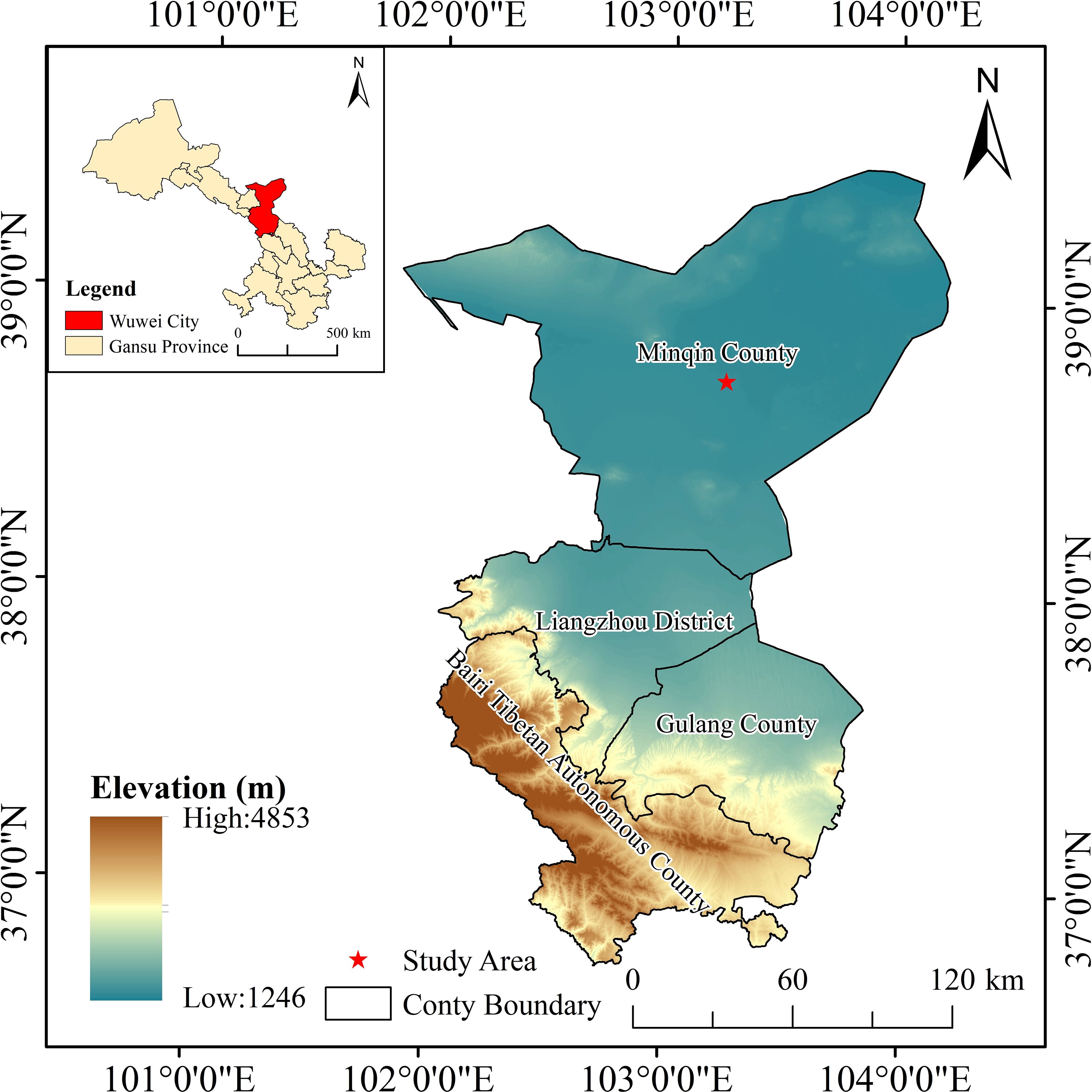
Figure 1. Geographical location of the test area (located in Minqin County, Gansu Province, China), indicated by the coordinates 38°37’ N latitude and 103°05’ E longitude, and an elevation of 1300 meters above sea level.
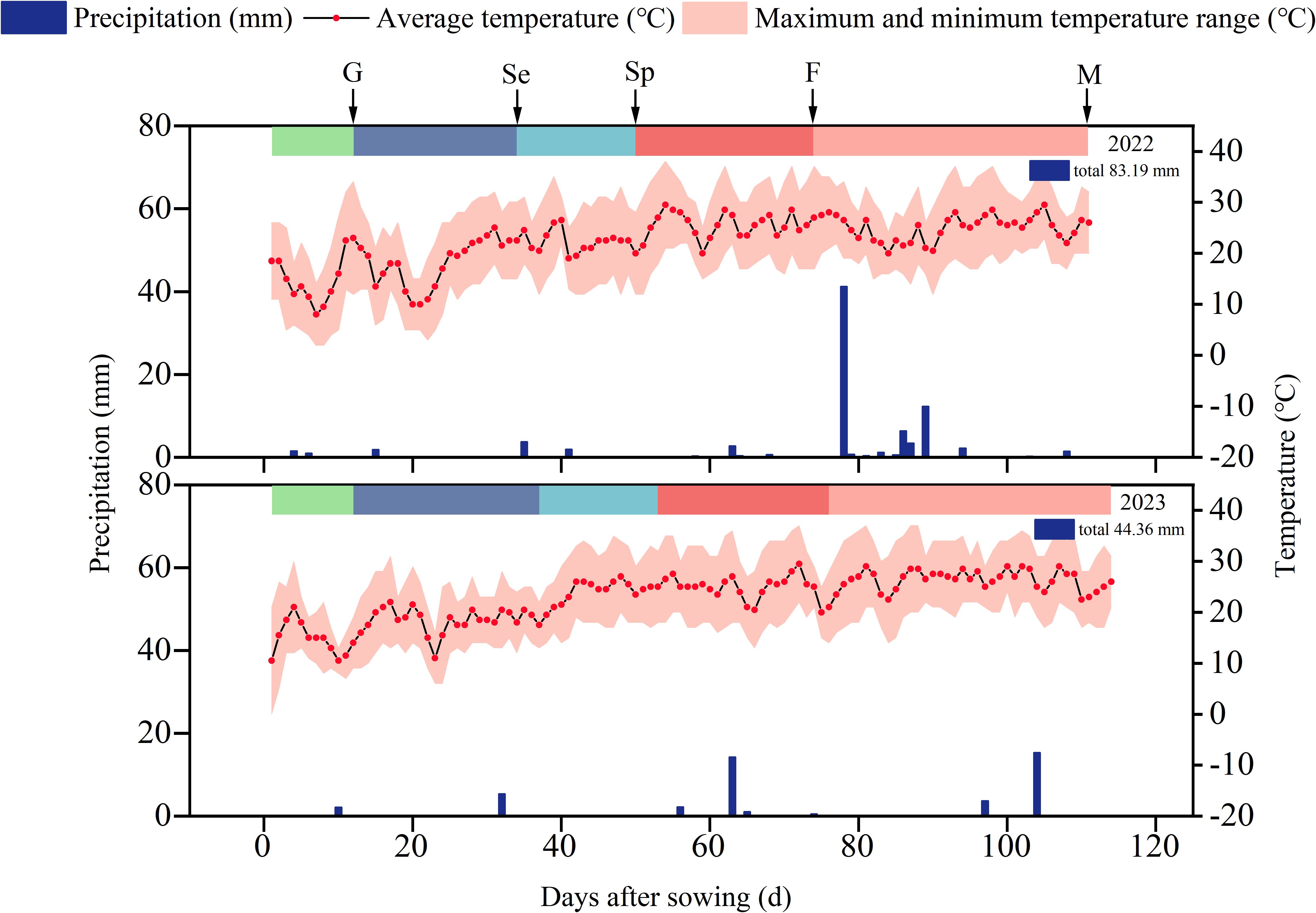
Figure 2. Daily precipitation and average air temperature during pumpkin growing season in 2022 and 2023. Different color blocks indicate different growth stages of pumpkin. G is germination stage, Se is seedling stage, Sp is the sprouting stage, F is flowering stage, M is maturity stage.
The experiment employed a completely randomized two-factor design, with two control factors: irrigation quota and organic fertilizer application amount. The irrigation quota and organic fertilizer application amount were selected based on local agricultural practices in arid northwest China. The irrigation quota consisted of three levels: W1 (375 m3·ha-1), W2 (450 m3·ha-1), and W3 (525 m3·ha-1). And there were three levels of organic fertilizer application: F1 (4500 kg·ha-1), F2 (5700 kg·ha-1), and F3 (6900 kg·ha-1). The control treatment (CK) represented the level of conventional irrigation and chemical fertilizer application used by local farmers, with an irrigation quota of 525 m3·ha-1 and a fertilizer level consisting of a base fertilizer of 300 kg·ha-1 diammonium phosphate and 450 kg·ha-1 urea, along with two top dressings of 300 kg·ha-1 urea each. A total of ten treatments were applied, with each treatment replicated three times on thirty 75 m2 (30 m×2.5 m) plots. Table 1 provides detailed information on the irrigation and fertilization scheme used in this study. Notably, top dressing was applied twice during both the late sprouting and flowering stages. To ensure seedling emergence, all treatments received one a pre-sowing irrigation event at a rate of 450 m3·ha-1. Throughout the growing season, irrigation was conducted thrice according to the experimental design.
The experimental pumpkin variety, ‘Sweet Pumpkin’, was sown on 24 April 2022 and 29 April 2023, and harvested on 12 August 2022 and 20 August 2023, respectively. The experiment employed a single furrow planting pattern with one film covering two rows. The large row spacing was set at 200 cm, while the small row spacing was maintained at 50 cm with a planting distance of 30 cm. The planting pattern is shown in Figure 3. Prior to sowing, the land was raked, leveled, furrowed and irrigated. The organic fertilizer used in this study was sourced from Lanzhou Xindali Water and Fertilizer Integrated Service Co., Ltd., and met the following criteria: N + P2O5 + K2O ≥18%, effective bacteria (Bacillus subtilis + Bacillus licheniformis) ≥0.5 million/ml, amino acids ≥3%.
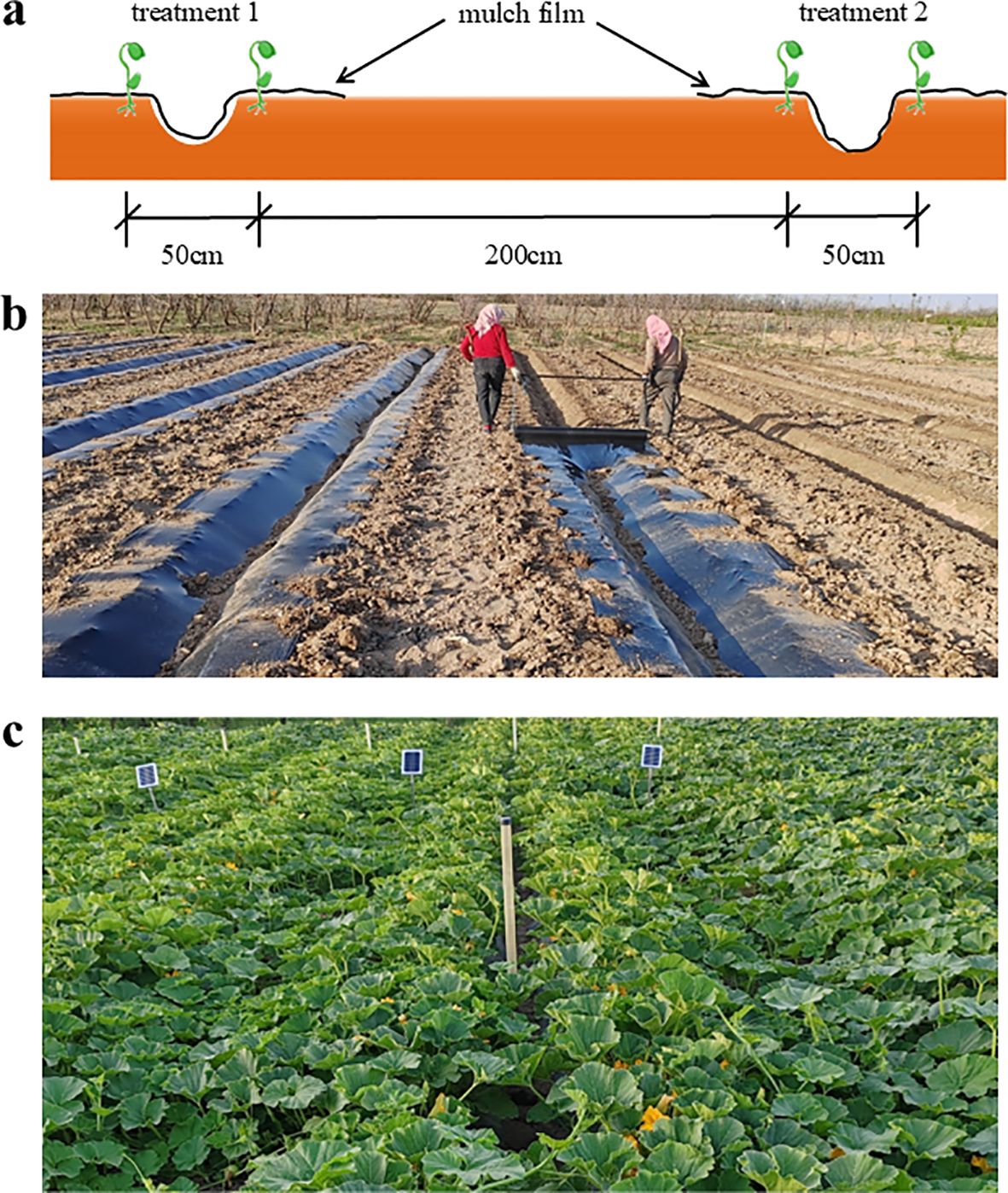
Figure 3. The design of field experiment in 2022 and 2023. Planting pattern (A). Photos of pumpkin planting photo (B) and pre-harvest pumpkin photo (C). Photos (B, C) were taken by the authors.
At each growth stage of pumpkin, soil samples were taken at intervals of 20 cm between 0 and 100 cm depth using the soil drilling method, and then analyzed for moisture content by a drying technique.
At each growth stage of pumpkin, three representative plants with uniform growth characteristics were randomly selected from each plot based on visual inspection and labeled. The vine length and stem diameter were measured using a tape and a caliper, respectively.
At each growth stage of pumpkin, three plants that appeared to be of average growth and health were randomly selected from each plot based on visual assessment and subjected to oven drying at 105°C for 30 minutes, followed by further drying at 75°C until a constant weight was reached. The dry matter weight of the above-ground portion in pumpkin plant was measured using an electronic balance with an accuracy of 0.01 g.
At maturity, three representative plants that exhibited average fruit size and uniformity were randomly sampled from each plot based on visual inspection to quantify the pumpkin fruit yield.
The irrigation water use efficiency (IWUE, kg·m-3) is calculated according to Equation 1:
Where Y is the yield of pumpkin, kg·ha-1; I is the irrigation amount, m3·ha-1.
The calculation of the partial fertilizer productivity (PFP, kg·kg-1) is shown in Equation 2:
Where Y is the yield of pumpkin, kg·ha-1; F is the total amount of fertilizer, kg·ha-1.
After the pumpkin reached maturity, three pumpkins that appeared to be of average size and uniformity were selected from each plot based on visual inspection to determine the levels of various quality indices. The concentrations of soluble sugars, vitamin C, and soluble solids in the pumpkin samples were quantified using a kit supplied by Beijing Box Biotechnology Co., Ltd.
Data compilation was done using Excel 2021, drawing was conducted with Origin 2023 software. Statistical analysis was performed using SPSS 26.0 software, with one-way ANOVA for each indicator among different treatments and Duncan’s method for multiple comparisons (P<0.05). Two-way ANOVA was employed to test the effects of irrigation quota and organic fertilizer application, as well as their interaction on the pumpkin (P<0.05). The different coupling modes of irrigation quota and organic fertilizer application were comprehensively evaluated using the TOPSIS method (Yu et al., 2023).
The dynamic changes of soil moisture content within the 0 ~ 100 cm depth during pumpkin growth period under different water and fertilizer coupling are illustrated in Figure 4. The temporal trend of soil moisture content within the 0 ~ 100 cm soil layer for each treatment remained generally consistent from 2022 to 2023. In terms of spatial distribution, there was an initial increase followed by a decrease in soil moisture content with increasing depth. Specifically, the soil moisture content gradually increased in the uppermost 0 ~ 50 cm soil layer, while it decreased with further depth in the lowermost 50 ~ 100 cm soil layer. Temporally, there was a decline in soil moisture content across all layers as the growth period progressed.
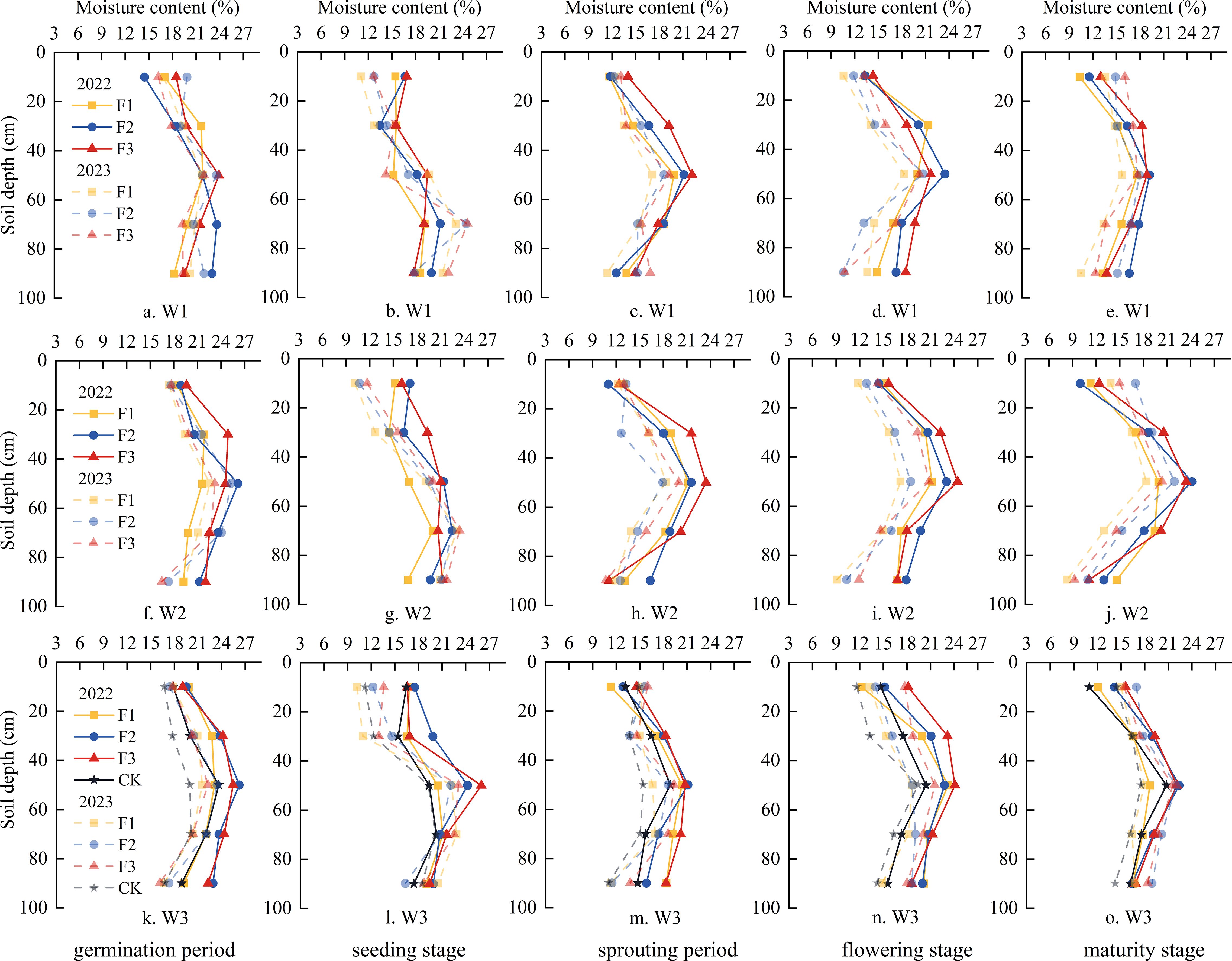
Figure 4. Effects of different water and fertilizer regulation on the water content of 0 ~ 100cm soil layer in each growth period of pumpkin. The actual line is the soil moisture content of each growth period in 2022, and the imaginary line is the soil moisture content of each growth period in 2023.
From an interannual perspective, at constant irrigation quotas, the soil moisture content at different growth stages increased with improving the application of organic fertilizer. Compared to the control group (CK), the average soil moisture content in the 100 cm soil layer increased by 4.3% ~ 12.48% for F1, 7.8% ~ 21.7% for F2, and 11.64% ~ 28.29% for F3 treatments, respectively. At the constant organic fertilizer application level, increasing irrigation amounts also resulted in higher soil moisture contents. The average soil moisture content in the 100 cm soil layer increased by 3.21% ~ 11.74%, 6.86% ~ 15.73% and 9.67% ~ 28.28% for W1, W2 and W3 treatments respectively compared with CK. These findings demonstrate that the coupling of water and fertilizer has a positive impact on the improvement of soil moisture content. Thus, applying organic fertilizer and increasing irrigation quotas are beneficial to improve soil moisture content.
The effects of irrigation quotas and organic fertilizer application rates on pumpkin vine length and stem diameter were highly significant (P < 0.01), while the interaction between water and fertilizer significantly influenced both vine length and stem diameter (P < 0.05) (Figure 5). In particular, in both years, stem diameter at the F3 level was significantly greater than that at the F1 and F2 levels (P < 0.05). Compared to the control (CK), stem diameter of pumpkin in the W1F3, W2F3, and W3F3 treatments increased by 7.72%, 11.5%, and 14.3%, respectively in 2022. In 2023, these increases were 1.78%, 8.53%, and 13.77%, respectively. With the exception of the F2, vine length during the sprouting period of pumpkin in 2022, which was significantly greater than that of F3 under W2 conditions (P < 0.05), vine length at the F3 level was significantly greater than that at F1 and F2 levels under W1, W2, and W3 conditions in all growth periods of both 2022 and 2023 (P < 0.05). At maturity stage, compared to CK, pumpkin vine lengths increased by 12.49%, 22.27%, and 31.97% respectively in W1F3, W2F3, and W3F3 treatments in 2022. Similarly, increases of 8.10%, 14.18%, and 28.82% were observed in these treatments during the study year in 2023 as well. These findings indicated that adequate irrigation coupled with organic fertilizer application enhanced both stem diameter growth and vine length development in pumpkin.
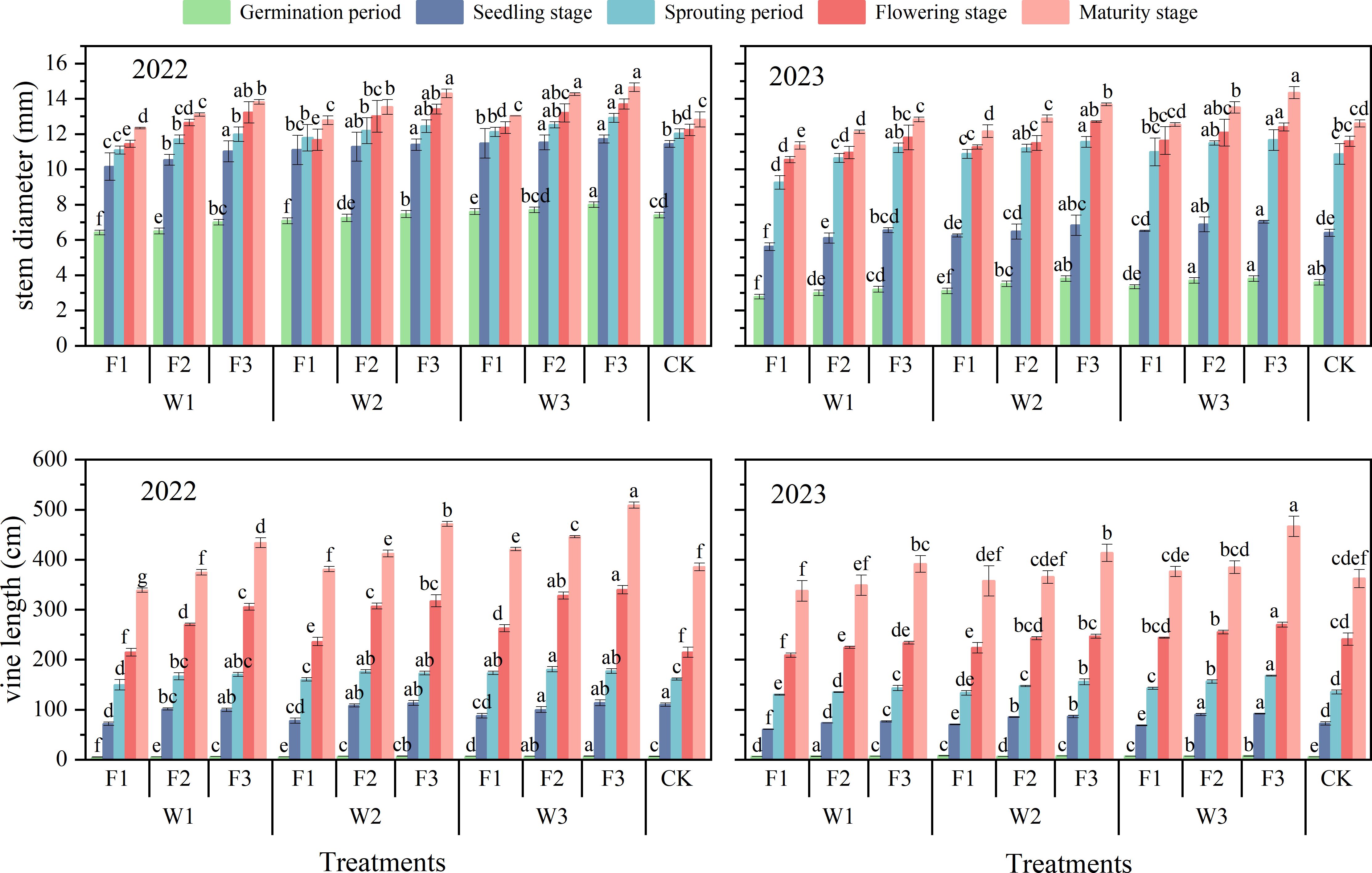
Figure 5. Effects of water and fertilizer coupling on stem diameter and vine length of pumpkin. Different lower case letters indicate significant differences between different treatments in the same growth period (P<0.05).
The above ground dry matter accumulation of pumpkin exhibited a curvilinear pattern throughout the entire growth period (Figure 6): increases were slow in both the early and late stages, with the most rapid growth occurring in the middle stage, and the maximum dry matter accumulation of pumpkin decreased with decreasing irrigation amounts. At identical fertilization levels, the two-year average maximum dry matter accumulation for W2 and W3 treatments increased by 33.2% and 73.8% respectively compared to W1. Within each growth period under consistent irrigation quotas, dry matter accumulation followed a trend of F2 > F3 > F1 for the different fertilization treatments. Notably, the average dry matter accumulation for W3F2 in each growth period was higher than that of the CK treatment by 80.9%, 33.5%, 46.3%, 47.1%, and 71.5%, respectively.
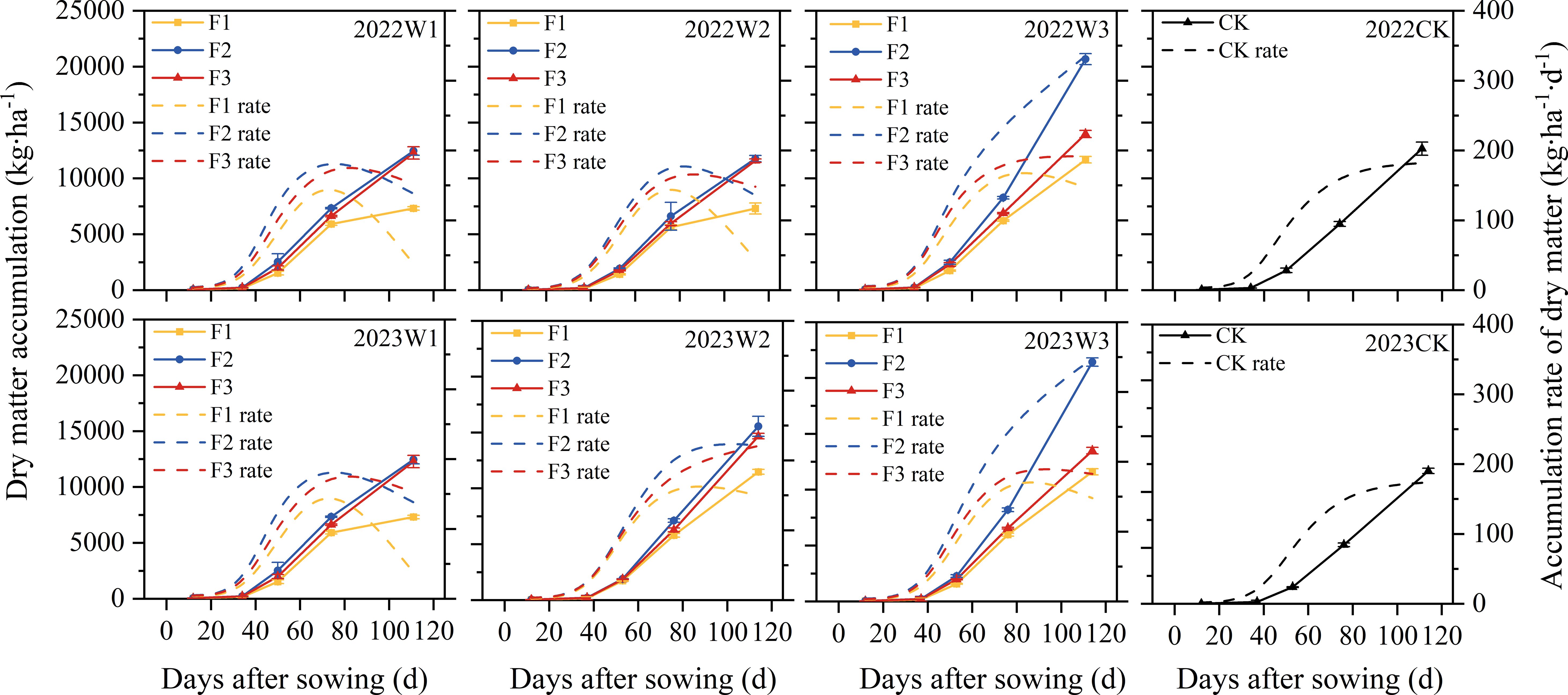
Figure 6. Effects of water and fertilizer coupling on dry matter accumulation and dry matter accumulation rate of pumpkin. The solid line and the dotted line represent dry matter accumulation and dry matter accumulation rate, respectively.
Table 2 revealed that irrigation, organic fertilizer, and water-fertilizer coupling had a highly significant impact on pumpkin yield (P<0.01). As the amount of irrigation increased, there was a significant increase in pumpkin yield. At the same fertilization level, the annual average total pumpkin yield under W3 was 17.36% and 7.91% higher than that of W1 and W2, respectively; and 12.51% higher than that of CK (24689.06 kg·ha-1). Among the W1 level, the total yield of W1F3 was the highest in 2022 and 2023, reaching 24635.06 kg·ha-1 and 24885.06 kg·ha-1, respectively. These values were significantly higher than those of W1F1 by 11.82% and 15.18%, respectively; and 1.7% and 1% higher than those of W1F2, respectively. In comparison to the CK treatment, there was a significant increase in yield for W1F3 in 2022; however, no significant difference was observed between the yields of WIF3 and the CK treatment in 2023. Among the W2 level, the total yield of W2F2 was the highest in 2022 and 2023. These yields were significantly higher than those of W2F1 by 14.24% and 13.4% respectively, and significantly higher than those of W2F3 by 4.98% and 3.95%, respectively. Furthermore, in both years there exhibited a significant increase compared to the CK treatment, exceeding it by 11.91% and 8.91%, respectively. Among the W3 level, the total yield of W3F2 was the highest in 2022 and 2023, exhibiting a significant increase of 23.33% and 18% compared to W3F1, as well as an impressive improvement of 18% and 17% when compared to W3F3. Furthermore, both years were significantly higher than the CK treatment with increases of 27% and 25% respectively. Under identical irrigation conditions (W2, W3) and different fertilization levels, pumpkin yield exhibited an initial increase followed by a subsequent decrease in response to organic fertilizer application.
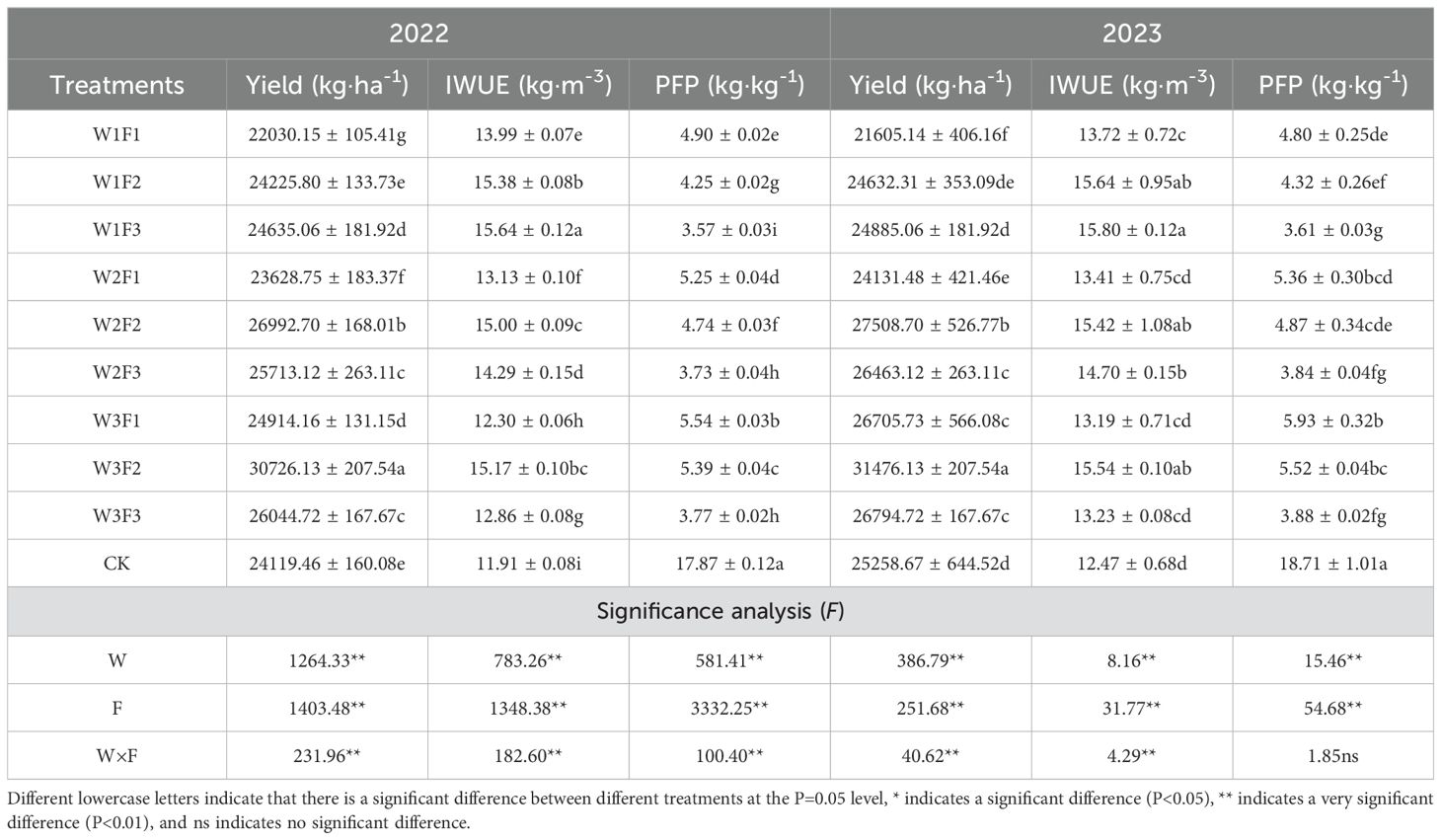
Table 2. Effects of water and fertilizer coupling on pumpkin yield, irrigation water use efficiency and fertilizer partial factor productivity.
The coupling of water and fertilizer in 2022 and 2023 significantly influenced irrigation water use efficiency (IWUE) of pumpkin (P < 0.01). Additionally, the coupling of water and fertilizer in 2022 had a significant impact on partial fertilizer productivity (PFP) (P < 0.01). The effects of irrigation and fertilization on IWUE and PFP were highly significant during both years. IWUE gradually decreased with increasing irrigation amount under the same organic fertilizer level. Conversely, under the same irrigation level (W2, W3), IWUE initially increased and then decreased with increasing organic fertilizer application. Notably, the impact of fertilization on IWUE surpassed that of irrigation. Under the W1F3 treatment, the IWUE of pumpkin in 2022 and 2023 which was significantly higher than that under other treatments. At a constant level of organic fertilizer application, PFP increased with increasing irrigation amount. Conversely, at a fixed irrigation level, PFP decreased with increasing organic fertilizer application. The influence of organic fertilizer application on PFP was found to be more pronounced than that of irrigation. Notably, due to the use of chemical fertilizers in the control treatment (CK), its PFP was significantly greater than that observed in the organic fertilizer treatments. In the W3F1 treatment, the PFP values for pumpkin in 2022 and 2023 were significantly higher than those of the other organic fertilizer treatments.
Using average data from 2022 and 2023, along with a two-year data set as an example, regression models were constructed with irrigation quota and organic fertilizer application amount as independent variables, while pumpkin soluble sugar, vitamin C, and soluble solids served as dependent variables (Figure 7). Regression analysis showed R² values of 0.920, 0.908, and 0.902 for the models of pumpkin soluble sugar, vitamin C, and soluble solids models, respectively, indicating a good model fit. Furthermore, the models exhibited significance at p<0.05 with F-values of 48.32, 41.61, and 38.56, respectively.

Figure 7. The regression relationship of soluble sugar, vitamin C and soluble solids in pumpkin under water and fertilizer coupling. (A–C), respectively represent the fitted model of soluble sugar, vitamin C and soluble solids in pumpkin, ** represent the significant difference when P is 0.01.
Irrigation, fertilization, and the coupling of water and fertilizer significantly influenced soluble sugars, vitamin C, and soluble solids (P<0.01). Under W1 conditions, the soluble sugar content increased with increasing organic fertilizer application; however, under W2 conditions, it initially increased before subsequently decreasing as organic fertilizer application rose. Vitamin C content in W2 was 20.7% ~ 24.8%, 5.5% ~ 6.5%, and 28.9% ~ 38.5% higher than those in W1, W3, and CK treatments, respectively. The highest vitamin C content was observed in the W2F2 treatment, while the lowest was found in the W1F1 treatment. Under F2 and F3 conditions, the soluble solids content showed an initial increase followed by a decrease with increasing irrigation amounts. At equivalent irrigation quota, the soluble solids content of the F2 treatment was found to be between 6.5% ~ 7.9%, 0.25% ~ 3%, and 9.4% ~ 10.7% higher than that of the F1, F3 and CK treatments, respectively.
To comprehensively assess the overall quality of pumpkin, the confidence ellipse was constructed and superimposed with 95% of the three quality indicators reaching the maximum value as the optimization condition (Figure 8). The optimal range of water and fertilizer coupling regulation to ensure the optimal quality of pumpkin was obtained: the ideal range of irrigation quota was 430-506 m3·ha-1, and the optimal range of organic fertilizer application was 5,373-6,570 kg·ha-1. In summary, the soluble sugar, vitamin C and soluble solids of the W2F2 treatment were all higher, and the pumpkin quality was the best.
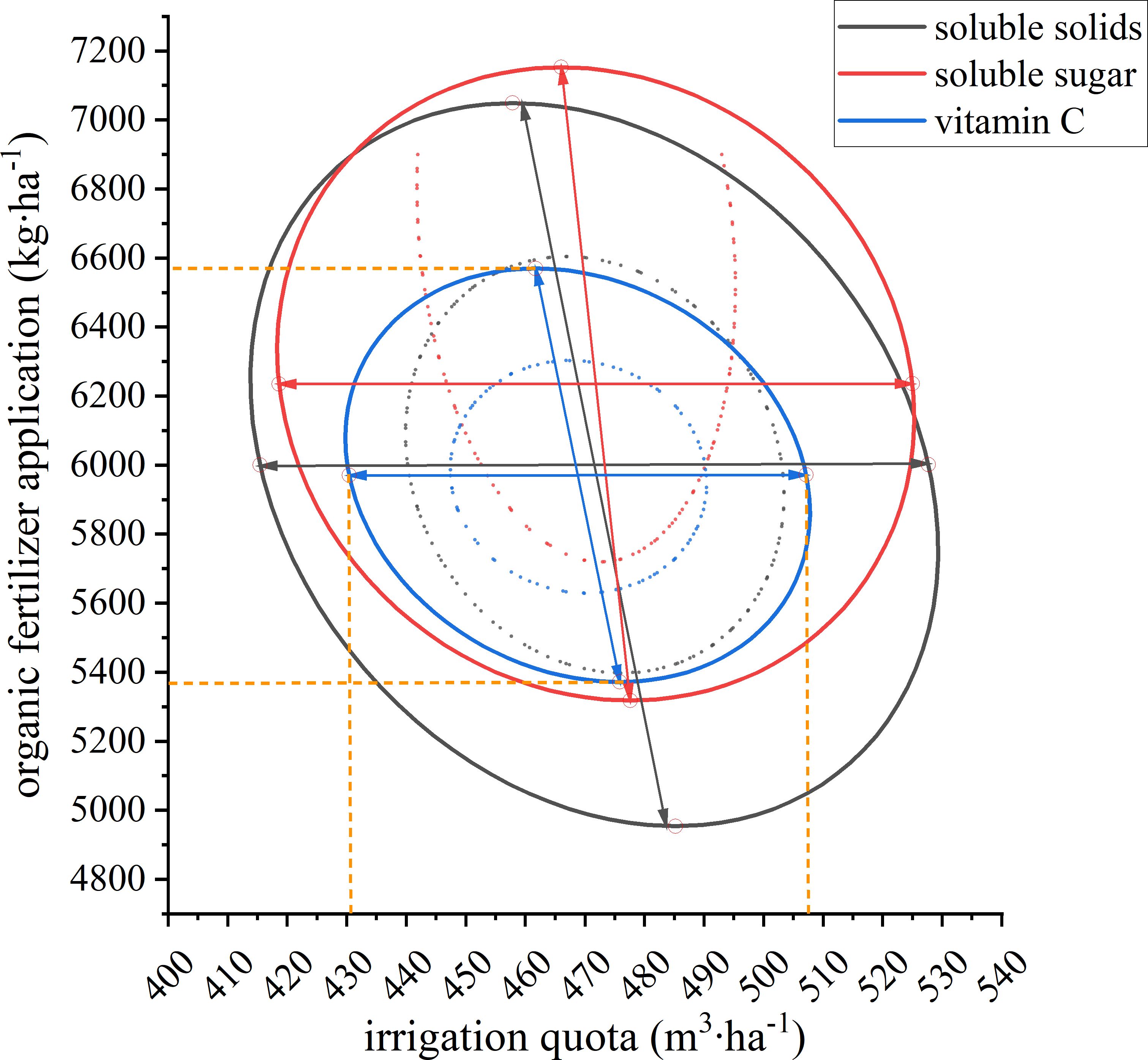
Figure 8. The optimal range of pumpkin quality under the coupling of water and fertilizer. Black ellipses, red ellipses, and blue ellipses indicate 95% optimal confidence intervals for soluble solids, soluble sugar, and vitamin C, respectively. The horizontal coordinates are the range of irrigation quotas covered by the confidence intervals, and the vertical coordinates are the range of organic fertilizer application covered by the confidence intervals.
Six evaluation indices across three dimensions — yield, water and fertilizer use efficiency (IWUE, PFP), and quality (soluble sugar, vitamin C, soluble solids) — were selected for the comprehensive evaluation using the TOPSIS method. The relative fitness and overall rankings of different combinations of irrigation quotas and organic fertilizer applications were presented in Table 3. In both 2022 and 2023, the W3F2 treatment achieved the highest overall ranking, followed by the W2F2 treatment. Conversely, the W1F1 treatment had the lowest ranking. Compared to the W1 treatment, both the W2 and W3 treatments demonstrated higher relative fitness and overall rankings. Additionally, the F2 treatment (excluding W1F2) exhibited superior relative fitness and overall rankings compared to the F1 and F3 treatments.
Soil moisture was a critical component of the soil and served as a vital source for water uptake by crops (Farrell et al., 2023). The status of soil moisture reflected the ability of soil to supply water, significantly influencing crop growth and yield. Results from Wang et al. (2024) indicated that the substitution of organic fertilizer for chemical nitrogen fertilizer reduced soil bulk density and solid phase, while increasing total soil porosity and water content. Furthermore, the application of organic fertilizer was shown to mitigate drought conditions (Tripathi et al., 2014). The field experiment conducted in this study demonstrated that the application of organic fertilizer significantly increased soil moisture content within the 0 ~ 50 cm soil layer. This enhancement was attributed to the optimization of soil structure facilitated by organic fertilizers, which increased both soil porosity and organic matter, thereby substantially improving soil water retention. During the decomposition of organic fertilizers, the formation of soil aggregates was promoted, further enhancing both water retention and permeability (Bai et al., 2024). Concurrently, organic fertilizers stimulated microbial activity in the soil, which not only promoted the development and stability of soil structure, but also indirectly enhanced its water-holding capacity (Jin et al., 2023), creating favorable conditions for both soil health and crop growth.
The judicious regulation of water and fertilizer application was a critical factor in promoting crop growth. Mu et al. (2023) demonstrated that irrigation and fertilization significantly affected the growth of Panax notoginseng. This study revealed that the regulation of water and fertilizer had a significant effect on both stem length and diameter of pumpkin (p < 0.05), with adequate irrigation combined with organic fertilizer application enhancing both stem diameter and length. Excessive fertilization could lead to water deficiency. Wang et al. (2023) demonstrated that the application of organic fertilizer under deficit irrigation could enhance dry matter accumulation in maize in semi-arid regions. This study found that at the same level of fertilization, dry matter accumulation in pumpkin was greater under high irrigation quota compared to medium and low irrigation quota, aligning with the findings of Guo et al. (2022). Under specific irrigation conditions, the F2 fertilization treatment exhibited superior dry matter accumulation in all growth periods, indicating that a moderate level of fertilization optimizes pumpkin growth and promotes efficient dry matter accumulation.
Pumpkin yield increased with higher irrigation quota, which was associated with an enhanced soil water availability. Conversely, the relationship between organic fertilizer amount applied and pumpkin yield exhibited an initial increasing trend, followed by a decreasing trend, indicating the existence of an optimal fertilization level. Exceeding this threshold may result in diminishing marginal returns. This study demonstrated that excessive fertilization could lead to reduced yields, with the W3F2 treatment producing the highest yield — 26% greater than the control (CK) treatment — suggesting that a judicious combination of water and fertilizer could effectively enhance pumpkin yield. Yan et al. (2022) demonstrated that excessive irrigation and fertilization not only led to resource wastage and environmental pollution, but also did not necessarily ensure high wheat yields due to plant overgrowth. Zhang et al. (2023a) discovered that moderate deficit irrigation can enhance crop yield, whereas excessive irrigation impairs root soil aeration and affects yield. In our study, the high irrigation quota (W3) increased pumpkin yield by 7.91% compared to the medium quota (W2), likely due to climatic differences, especially 363 mm more annual precipitation at Zhang’s site. These findings underscore the importance of tailored irrigation strategies for optimizing crop production under specific environmental conditions. In this study, IWUE and PFP, key indicators for evaluating the coupling efficiency of water and fertilizer, exhibited variations with different levels of irrigation and fertilization. Specifically, IWUE gradually decreased as irrigation amounts increased, while PFP showed an increase with higher irrigation levels, this is consistent with the findings of Zhang et al. (2023a). This indicated the need to focus on water and fertilize use efficiency, alongside yield enhancement to achieve sustainable development. Optimizing water and fertilizer management strategies, such as adjusting irrigation quotas and fertilizer applications, may enhance resource use efficiency while minimizing waste.
The pumpkin quality directly affected their flavor, taste and nutritional value, which determined their market value. Vitamin C was an important vitamin in the human diet nutrition that significantly impacted the edible value of pumpkin (Buzigi et al., 2022). It was indicated that a moderate water deficit positively affected the soluble sugar content of pumpkin (Li et al., 2022). Zhang et al. (2024) found that the application of a certain amount of organic fertilizer could significantly enhance both vitamin and soluble sugar content in pumpkin compared to the application of chemical fertilizer alone. Notably, vitamin C content was the highest in the 100% organic fertilizer treatment at 39.20 mg·100g-1. In this study, the vitamin C content was the highest in the W2F2 treatment, averaging 28.85 mg·100g-1 over two years. The soluble sugar content under the W2 level was 2.74% ~ 3.39%, higher than that under the W3 treatment. In summary, these findings indicated that the application of a certain amount of organic fertilizer and irrigation could enhance pumpkin quality under the experimental conditions, which aligned with the results reported by Youssef et al. (2021).
Although the present study explored the relationship between soil water content, pumpkin growth indicators, yield and quality in response to water-fertilizer coupling, it did not involve the quantitative analysis of the causal relationship between the indicators, and future studies can further explore the intrinsic mechanism of the indicators using regression analysis methods such as structural equation modelling.
Based on a two-year field experiment, this study elucidated the effects of water and fertilizer coupling on pumpkin growth and quality under organic fertilization conditions.
1. Moderate irrigation combined with organic fertilizer application significantly enhanced soil moisture content especially at 50 cm depth, and significantly increased the dry matter accumulation of pumpkin, with the accumulation rate peaking at 60-80 days after sowing.
2. When only quality indicators were considered, the W2F2 treatment performed well in increasing the soluble sugar, vitamin C, and soluble solids content of pumpkin, thereby optimizing its quality.
3. The W3F2 treatment (525 m³·ha⁻¹ irrigation quota and 5,700 kg·ha⁻¹ organic fertilizer application rate) was a more suitable water-fertilizer coupling management strategy for pumpkin cultivation in the arid region of northwest China than the other treatments when evaluated comprehensively in terms of yield, quality and water and fertilizer use efficiency using the TOPSIS method.
The raw data supporting the conclusions of this article will be made available by the authors, without undue reservation.
MY: Conceptualization, Data curation, Formal analysis, Methodology, Visualization, Writing – original draft, Writing – review & editing. JZ: Project administration, Resources, Supervision, Writing – review & editing. LDu: Formal analysis, Validation, Writing – review & editing. LDi: Formal analysis, Funding acquisition, Resources, Writing – review & editing. TZ: Software, Writing – review & editing. PT: Software, Writing – review & editing. RY: Data curation, Writing – review & editing.
The author(s) declare financial support was received for the research, authorship, and/or publication of this article. This work was funded by the 2024 Gansu Province Higher Education Innovation Fund Project (2024A-063), the sub project of Gansu Provincial Major Science and Technology Special Project (23ZDFA009-04-02), the Technical Consulting Project of Gansu Provincial Department of Water Resources (GSAU-JSZX-2023-001), the “Innovative Team for Water Saving Irrigation and Water Resource Regulation in Arid Irrigation Areas” in the discipline of water conservancy engineering at Gansu Agricultural University (GSAU-XKJS-2023-38), and Gansu Province Water Conservancy Research and Technology Promotion Plan Project (202204, 23 GSLK012, 23 GSLK013).
We thank editors and reviewers for their valuable comments and suggestions on the manuscript.
The authors declare that the research was conducted in the absence of any commercial or financial relationships that could be construed as a potential conflict of interest.
The author(s) declare that no Generative AI was used in the creation of this manuscript.
All claims expressed in this article are solely those of the authors and do not necessarily represent those of their affiliated organizations, or those of the publisher, the editors and the reviewers. Any product that may be evaluated in this article, or claim that may be made by its manufacturer, is not guaranteed or endorsed by the publisher.
Ali, S., Jan, A., Manzoor, N., Sohail, A., Khan, A., Khan, M. I., et al. (2018). Soil amendments strategies to improve water-use efficiency and productivity of maize under different irrigation conditions. Agric. Water Manag. 210, 88–95. doi: 10.1016/j.agwat.2018.08.009
Bai, H. M., Liu, M. Y., Jing, Y. P., Li, Y. J., Chen, S. H., Xue, G. P., et al. (2024). Effects of organic fertilizer with different degrees of maturity on bacteria in saline-alkali soil. Agronomy-Basel 14 (6), 1148. doi: 10.3390/agronomy14061148
Bai, Y., Zhang, M., Chandra Atluri, S., Chen, J., Gilbert, R. G. (2020). Relations between digestibility and structures of pumpkin starches and pectins. Food Hydrocoll. 106, 105894. doi: 10.1016/j.foodhyd.2020.105894
Buzigi, E., Pillay, K., Siwela, M. (2022). Potential of pumpkin to combat vitamin a deficiency during complementary feeding in low and middle income countries: variety, provitamin a carotenoid content and retention, and dietary reference intakes. Crit. Rev. Food. Sci. Nutr. 62, 6103–6112. doi: 10.1080/10408398.2021.1896472
Cai, W., Jiang, X., Sun, H., He, J., Deng, C., Lei, Y. (2022). Temporal and spatial variation and driving factors of water consumption in the middle heihe river basin before and after the implementation of the"97 water diversion scheme. Agric. Water Manag. 269, 107727. doi: 10.1016/j.agwat.2022.107727
Chen, Q., Lyu, Y., Bi, J., Wu, X., Jin, X., Qiao, Y., et al. (2019a). Quality assessment and variety classification of seed-used pumpkin by-products: potential values to deep processing. Food Sci. Nutr. 7 (12), 4095–4104. doi: 10.1002/fsn3.1276
Chen, Y., Zhou, X., Lin, Y., Ma, L. (2019b). Pumpkin yield affected by soil nutrients and the interactions of nitrogen, phosphorus, and potassium fertilizers. Hortscience. 54 (10), 1831–1835. doi: 10.21273/hortsci14152-19
Farrell, M., Leizica, E., Gili, A., Noellemeyer, E. (2023). Identification of management zones with different potential moisture availability for sustainable intensification of dryland agriculture. Precis. Agric. 24, 1116–1131. doi: 10.1007/s11119-023-10002-2
Food and Agricultural Organization (2021). The state of food security and nutrition in the world 2021. Available online at: https://data.unicef.org/resources/sofi-2021/. (Accessed July 12, 2021).
Guo, J., Fan, J., Xiang, Y., Zhang, F., Yan, S., Zhang, X., et al. (2022). Coupling effects of irrigation amount and nitrogen fertilizer type on grain yield, water productivity and nitrogen use efficiency of drip-irrigated maize. Water Manag. 261, 107389. doi: 10.1016/j.agwat.2021.107389
Hui, K., Xi, B., Tan, W., Song, Q. (2022). Long-term application of nitrogen fertilizer alters the properties of dissolved soil organic matter and increases the accumulation of polycyclic aromatic hydrocarbons. Environ. Res. 215, 114267. doi: 10.1016/j.envres.2022.114267
Jin, J., Khan, S., Eltohamy, K. M., He, S., Liu, C., Li, F., et al. (2023). Biochar–coupled organic fertilizer reduced soil water-dispersible colloidal phosphorus contents in agricultural fields. Chemosphere. 333, 138963. doi: 10.1016/j.chemosphere.2023.138963
Li, X., Liu, H., He, X., Gong, P., Lin, E. (2019). Water–nitrogen coupling and multi-objective optimization of cotton under mulched drip irrigation in arid northwest China. Agronomy. 9 (12), 894. doi: 10.3390/agronomy9120894
Li, X., Zhang, H., Li, F., Deng, H., Wang, Z., Chen, X. (2022). Evaluating effects of regulated deficit irrigation under mulched on yield and quality of pumpkin in a cold and arid climate. Water. 14 (10), 1563. doi: 10.3390/w14101563
Li, Y., Wang, R., Chen, Z., Xiong, Y., Huang, Q., Huang, G. (2023). Increasing net ecosystem carbon budget and mitigating global warming potential with improved irrigation and nitrogen fertilization management of a spring wheat farmland system in arid northwest China. Plant Soil. 489 (1), 193–209. doi: 10.1007/s11104-023-06006-6
Liu, X., Li, M., Guo, P., Zhang, Z. X. (2019). Optimization of water and fertilizer coupling system based on rice grain quality. Agric. Water Manage. 221, 34–46. doi: 10.1016/j.agwat.2019.04.009
Liu, Z., Qiao, D., Liu, Z., Wang, P., Sun, L., Li, X. (2023). Evaluation of waterlogging tolerance and responses of protective enzymes to waterlogging stress in pumpkin. Peerj. 11, e15177. doi: 10.7717/peerj.15177
Luo, H., Wang, P., Wang, Q., Lyu, X., Zhang, E., Yang, X., et al. (2024). ). Pollution sources and risk assessment of potentially toxic elements in soils of multiple land use types in the arid zone of northwest China based on monte carlo simulation. Ecotoxicol. Environ. Saf. 279, 116479. doi: 10.1016/j.ecoenv.2024.116479
Mu, T., Yue, X., Zang, Z., Wang, H., Liang, J., Yang, Q., et al. (2023). Coupling effect of water and soluble organic fertilizer on yield and quality of panax notoginseng under micro-sprinkler irrigation in southwest China. Agronomy-Basel 13 (7), 1742. doi: 10.3390/agronomy13071742
Qi, D., Hu, T., Song, X. (2020). Effects of nitrogen application rates and irrigation regimes on grain yield and water use efficiency of maize under alternate partial root-zone irrigation. J. Integr. Agric. 19 (11), 2792–2806. doi: 10.1016/s2095-3119(20)63205-1
Sá, A. G. A., Pacheco, M. T. B., Moreno, Y. M. F., Carciofi, B. A. M. (2023). Processing effects on the protein quality and functional properties of cold-pressed pumpkin seed meal. Food Res. Int. 169, 112876. doi: 10.1016/j.foodres.2023.112876
Shan, X., Cui, N., Cai, H., Hu, X., Zhao, L. (2020). Estimation of summer maize evapotranspiration using mars model in the semi-arid region of northwest China. Comput. Electron. Agric. 174, 105495. doi: 10.1016/j.compag.2020.105495
Stoleru, V., Inculet, S. C., Mihalache, G., Cojocaru, A., Teliban, G. C., Caruso, G. (2020). Yield and nutritional response of greenhouse grown tomato cultivars to sustainable fertilization and irrigation management. Plants 9 (8), 1053.. doi: 10.3390/plants9081053
Su, Q., Cang, B., Ullah, R., Song, Z., Li, Y., Cui, J., et al. (2023). Interaction of the coupled effects of irrigation mode and nitrogen fertilizer timing on rice yield in different regions. Irrig. Drain. 72, 999–1012. doi: 10.1002/ird.2822
Tang, Q., Ti, C., Xia, L., Xia, Y., Wei, Z., Yan, X. (2019). ). Ecosystem services of partial organic substitution for chemical fertilizer in a peri-urban zone in China. J. Clean. Prod. 224, 779–788. doi: 10.1016/j.jclepro.2019.03.201
Tripathi, R., Nayak, A. K., Bhattacharyya, P., Shukla, A. K., Shahid, M., Raja, R., et al. (2014). Soil aggregation and distribution of carbon and nitrogen in different fractions after 41years long-term fertilizer experiment in tropical rice–rice system. Geoderma. 213, 280–286. doi: 10.1016/j.geoderma.2013.08.031
Walters, S. A. (2020). Impact of nitrogen fertilizer on yield and associated revenues in no-tillage pumpkin. Hortscience. 55 (4), 522–527. doi: 10.21273/hortsci14512-19
Wang, J., Han, G., Duan, Y., Han, R., Shen, X., Wang, C., et al. (2024). Effects of different organic fertilizer substitutions for chemical nitrogen fertilizer on soil fertility and nitrogen use efficiency of foxtail millet. Agronomy. 14 (4), 866. doi: 10.3390/agronomy14040866
Wang, H., Wu, L., Wang, X., Zhang, S., Cheng, M., Feng, H., et al. (2021). Optimization of water and fertilizer management improves yield, water, nitrogen, phosphorus and potassium uptake and use efficiency of cotton under drip fertigation. Agric. Water Manag. 245, 106662. doi: 10.1016/j.agwat.2020.106662
Wang, X., Xing, Y. (2017). Evaluation of the effects of irrigation and fertilization on tomato fruit yield and quality: a principal component analysis. Sci. Rep. 7, 350. doi: 10.1038/s41598-017-00373-8
Wang, N., Zhang, T. H., Cong, A. Q., Lian, J. (2023). Integrated application of fertilization and reduced irrigation improved maize (Zea mays L.) Yield, crop water productivity and nitrogen use efficiency in a semi-arid region. Agric. Water Manag 289, 108566. doi: 10.1016/j.agwat.2023.108566
Wang, Y., Zhu, Y. C., Zhang, S. X., Wang, Y. Q. (2018). What could promote farmers to replace chemical fertilizers with organic fertilizers? J. Clean. Prod. 199, 882–890. doi: 10.1016/j.jclepro.2018.07.222
Wu, Y., Du, T. (2020). Evaporation and its influencing factors in farmland soil in the arid region of Northwest China. Trans. Chin. Soc. Agric. Eng. 36, 110–116. Available at: https://kns.cnki.net/kcms2/article/abstract?v=IXLqNOIxNnvxfu3hzXo7P6BaGIuIrslELArIzOElQozbxUb77g-aHlck5hRaG798zM2jcB0_HulCJGJZWsJ6cdHUTqlZTo9-2V9ebOi5wCNZvpacGY7gBrhuol5FHShQoPt1yYnWreLZ6xDvRTu_N60GjiRUOWX51i6VAKJW-0h8ZMQBiH-qL2intULOhUMqV-6_ltc4ZfM=&unipl. (Accessed July 20, 2020).
Wu, G., Yang, S., Luan, C., Wu, Q., Lin, L., Li, X., et al. (2024). Partial organic substitution for synthetic fertilizer improves soil fertility and crop yields while mitigating n2o emissions in wheat-maize rotation system. Eur. J. Agron. 154, 127077. doi: 10.1016/j.eja.2023.127077
Yan, S. C., Wu, Y., Fan, J. L., Zhang, F. C., Guo, J. J., Zheng, J., et al. (2022). Optimization of drip irrigation and fertilization regimes to enhance winter wheat grain yield by improving post-anthesis dry matter accumulation and translocation in northwest China. Agric. Water Manag 271, 107782. doi: 10.1016/j.agwat.2022.107782
Yavuz, D., Seymen, M., Yavuz, N., Türkmen, Ö. (2015). Effects of irrigation interval and quantity on the yield and quality of confectionary pumpkin grown under field conditions. Agric. Water Manag. 159, 290–298. doi: 10.1016/j.agwat.2015.06.025
Youssef, M. A., al-Huqail, A. A., Ali, E. F., Majrashi, A. (2021). Organic amendment and mulching enhanced the growth and fruit quality of squash plants (cucurbita pepo l.) Grown on silty loam soils. Horticulturae. 7 (9), 269. doi: 10.3390/horticulturae7090269
Yu, X., Zhang, J., Zhang, Y., Ma, L., Jiao, X., Zhao, M., et al. (2023). Identification of optimal irrigation and fertilizer rates to balance yield, water and fertilizer productivity, and fruit quality in greenhouse tomatoes using topsis. Sci. Hortic. 311, 111829. doi: 10.1016/j.scienta.2023.111829
Yu, L., Zhao, X., Gao, X., Siddique, K. H. M. (2020). Improving/maintaining water-use efficiency and yield of wheat by deficit irrigation: a global meta-analysis. Agric. Water Manag. 228, 105906. doi: 10.1016/j.agwat.2019.105906
Zeng, S. Y., Ma, J., Yang, Y. J., Zhang, S. L., Liu, G. J., Chen, F. (2019). Spatial assessment of farmland soil pollution and its potential human health risks in China. Sci. Total Environ. 687, 642–653. doi: 10.1016/j.scitotenv.2019.05.291
Zhang, F., Chen, M., Fu, J., Zhang, X., Li, Y., Shao, Y., et al. (2023a). Coupling effects of irrigation amount and fertilization rate on yield, quality, water and fertilizer use efficiency of different potato varieties in northwest China. Agric. Water Manage. 287, 108446. doi: 10.1016/j.agwat.2023.108446
Zhang, S., Zamanian, K., Raza, S., Raheb, A., Feng, Y., Zhao, X. (2023b). A balance among irrigation and fertilization regimes to reduce greenhouse gases emissions from saline and alkaline soils. Land Degrad. Dev. 35 (1), 168–182. doi: 10.1002/ldr.4907
Zhang, J., Zhou, Q., Wang, Y., Liu, Q., Shi, Z., Ma, F., et al. (2024). Effects of increasing organic fertilizer on the quality of sandy soil in Hexi Corridor and the growth of Beibei pumpkin. China Cucurbits Vegetables. 37, 95–103. doi: 10.16861/j.cnki.zggc.202423.0496
Zhao, G., Zhu, X., Zheng, G., Meng, G., Dong, Z., Baek, J. H., et al. (2024). Development of biofertilizers for sustainable agriculture over four decades, (1980–2022). Geogr. Sustain. 5, 19–28. doi: 10.1016/j.geosus.2023.09.006
Keywords: water-fertilizer coupling, pumpkin yield and quality, irrigation water use efficiency, partial fertilizer productivity, TOPSIS
Citation: Yin M, Zhang J, Du L, Ding L, Zhong T, Tian P and Yang R (2025) Effects of irrigation and organic fertilizer on pumpkin yield, quality, and water-fertilizer use efficiency in arid northwest China. Front. Plant Sci. 16:1517761. doi: 10.3389/fpls.2025.1517761
Received: 27 October 2024; Accepted: 20 January 2025;
Published: 07 February 2025.
Edited by:
Qi Wu, Shenyang Agricultural University, ChinaReviewed by:
Fucang Zhang, Northwest A&F University, ChinaCopyright © 2025 Yin, Zhang, Du, Ding, Zhong, Tian and Yang. This is an open-access article distributed under the terms of the Creative Commons Attribution License (CC BY). The use, distribution or reproduction in other forums is permitted, provided the original author(s) and the copyright owner(s) are credited and that the original publication in this journal is cited, in accordance with accepted academic practice. No use, distribution or reproduction is permitted which does not comply with these terms.
*Correspondence: Jinxia Zhang, amlueGlhemhhbmcxOTc3QDE2My5jb20=
Disclaimer: All claims expressed in this article are solely those of the authors and do not necessarily represent those of their affiliated organizations, or those of the publisher, the editors and the reviewers. Any product that may be evaluated in this article or claim that may be made by its manufacturer is not guaranteed or endorsed by the publisher.
Research integrity at Frontiers

Learn more about the work of our research integrity team to safeguard the quality of each article we publish.